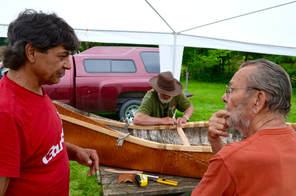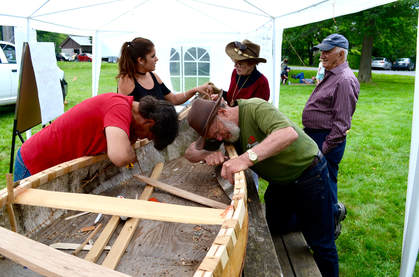|
This week’s invasive species is curlyleaf pondweed (Potomogeton crispus). This aquatic plant can grow in low light and low temperatures. Here are some interesting facts about the plant:
0 Comments
This week’s invasive species is Eurasian water-milfoil (Myriophyllum spicatum). This perennial aquatic plant has two look alikes- the native species northern water-milfoil and the invasive species parrot feather. The key difference between Eurasian water-milfoil and northern water-milfoil is that the latter has leaves with 11 or fewer leaf segments. Parrot feather has not yet been detected in Ontario. Here are some fast facts about the species:
 Plenty Canada’s appearance at the Stewart Park Festival was another resounding success! Thank you, miigwetch, to everyone who came to visit the workshop provided by Plenty Canada and the Lanark County Neighbours for Truth and Reconciliation on the weekend. Attendees were invited to see the birch bark canoe building process in person, and talk with Larry, Chuck, and volunteers about our reconciliation projects, and the significance of the canoe to the culture of Indigenous peoples. Similar to our July 3rd workshop, we invited people to anonymously write down what reconciliation means to them, and what they would like to see done about the issue. The responses were both varied and informative--check them out below! What does reconciliation mean to you? What would you like to see done?
We will continue bringing communities together through further discussion at our events, reigniting the spirit of nation-to-nation dialogue and respect for each other, the land, and our future generations. Stay tuned for more of Plenty Canada’s events including the “Renewing our Friendship” event in Almonte August 19th, the Silver Lake Pow Wow August 26th and 27th, and our traditional feast in mid September. Plenty Canada wants to hear what reconciliation means to you! Share your thoughts in a comment below. This week's invasive species is garlic mustard (Alliaria petiolata). Here are some quick facts about the plant:
This week’s invasive species is invasive Phragmites. This plant, like many other invasive species, has a native species look-a-like. However, there are some key differences to keep in mind when trying to tell them apart.
Thank you, miigwetch, to everybody who attended our July 3rd canoe workshop! It was a wonderful afternoon of sharing and learning, featuring an opening ceremony, educational videos on biosphere reserves and invasive species, and a nature walk on the William Commanda trail. One of the most successful portions of our event was the sharing circle on reconciliation. We asked attendees to tell us what reconciliation meant to them, providing us with a wealth of informative and insightful responses.
This was an amazing realization of our event's main goal—to build relationships and a sense of understanding between local Indigenous and non-Indigenous people. Check out the responses! Understanding & action. Learning about our history. Collaboration. Integrating all our histories into our teachings. Abolition of private property. Honouring responsibilities, and respect for different ways of knowing. Sharing our individual strengths & learning to become a human family. Listening. Forgiveness. Respect. Being mindful. Understanding. One people. Responsibility to the land. Healing, respect for all creation. Learning. Role modelling for friends & family. Passing positive messages to children. Love & compassion. Questioning ownership of land. Sharing based on local needs as beginning steps. Rewriting our history together. Telling stories of people & land. Treaties signed and those to come. Communication, understanding of different ways of living on land. Respect differences. Communicate & speak frankly. Respect for First peoples’ values, and respect for land as not just a source of resources. Open minds—hearing stories, changing behaviours. Listening to stories of trauma with love. Educating ourselves. Connecting with our hearts, with empathy & gratitude. New ways of communicating with youth & adults. Restitution & respect, giving back what was taken (land, cultural materials). Reclaiming, passing on to children. Complex, deep, hard to get one's head around it. Every aspect of society has been colonized. Nation to nation—learning to respect both ways of living, and drawing on the strengths of both. Energy of new generations. Can there be reconciliation? Hopeful for future generations. Learning, sharing, understanding, nation-to-nation, common goals. Following the Creator's original instructions. Plenty Canada’s event in Lanark county was an act of reconciliation itself, and an important step to further the broader goal of reconciliation throughout Canada. Being able to come together in a spirit of mutual respect and understanding brings us all closer to building a nation that respects the rights of all communities, future generations, and the land we love. |
|
-
Home
- Donate
-
Projects
-
Canada
>
- Plenty Canada CampUs
- The Healing Places
- Two-Eyed Seeing Bird Knowledge
- Niagara Escarpment Biosphere Network
- Greenbelt Indigenous Botanical Survey
- Great Niagara Escarpment Indigenous Cultural Map
- Ginawaydaganuc Indigenous Food Sovereignty
- Indigenous Languages and Cultures Programs >
- Wild Rice
- Good Mind Grappling (partnership)
- Ginawaydaganuc Village (partnership)
- Youth Programming >
- Americas >
- Africa >
-
Canada
>
- News
- Resources
- Partners
- Contact Us
Our Location266 Plenty Lane Lanark, Ontario Canada K0G 1K0 (613) 278-2215 |
Donate to
|
Subscribe to our Newsletter |






